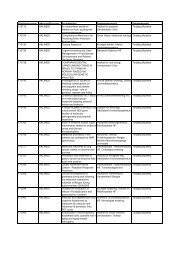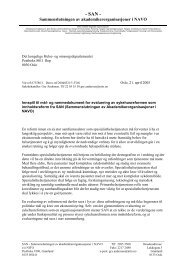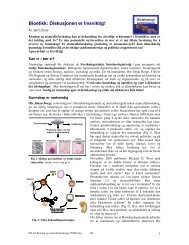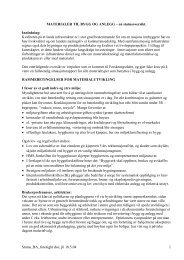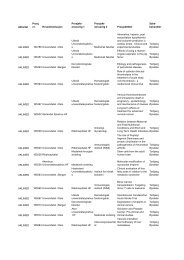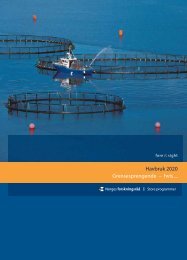A Revolution in R&D
A Revolution in R&D
A Revolution in R&D
Create successful ePaper yourself
Turn your PDF publications into a flip-book with our unique Google optimized e-Paper software.
CHEMICAL GENOMICS—FORWARD OR REVERSE<br />
When companies say they are pursu<strong>in</strong>g chemical<br />
genomics, they are usually referr<strong>in</strong>g to large-scale<br />
reverse chemical genetics. (That is how the term is<br />
used <strong>in</strong> our report.) This approach <strong>in</strong>volves f<strong>in</strong>d<strong>in</strong>g<br />
chemical compounds that b<strong>in</strong>d to a known target.<br />
Companies often perform this task for entire target<br />
classes; it is especially popular for prote<strong>in</strong> classes<br />
that are known to be highly drugable, such as Gprote<strong>in</strong><br />
coupled receptors (GPCRs). The assay for<br />
b<strong>in</strong>d<strong>in</strong>g does not need to provide functional <strong>in</strong>formation<br />
relevant to a specific disease state—biological<br />
function can be assessed <strong>in</strong> validation experiments.<br />
The alternative is forward chemical genetics. This<br />
approach beg<strong>in</strong>s with functional knowledge. A<br />
library of compounds is screened <strong>in</strong> an assay that<br />
tests for changes <strong>in</strong> a specific biological function.<br />
One immediate result would be to process the glut<br />
of identified targets more quickly: <strong>in</strong>stead of jo<strong>in</strong><strong>in</strong>g<br />
the logjam at the validation stage, a great many<br />
of them can now be diverted directly to screen<strong>in</strong>g.<br />
If they fail there, they can be discarded right away,<br />
and thus simply bypass most of the validation stage<br />
altogether. In other words, screen<strong>in</strong>g moves up the<br />
value cha<strong>in</strong> to rest alongside validation, <strong>in</strong> a parallel<br />
rather than consecutive position. By bracket<strong>in</strong>g<br />
the <strong>in</strong>dustrialized steps of target identification and<br />
chemical screen<strong>in</strong>g, chemical genomics has given<br />
the value cha<strong>in</strong> a remarkable makeover.<br />
The key is to move lengthy, messy biology far downstream<br />
where you know it’s worth pursu<strong>in</strong>g. Many<br />
targets aren’t drugable, so just validate the smaller<br />
drugable subset.<br />
—SVP of discovery,<br />
lead<strong>in</strong>g biotech company<br />
The effect of this new value cha<strong>in</strong> is dramatic: time<br />
to drug is cut by a further two years (that’s on top<br />
of the year already saved by us<strong>in</strong>g genomic target<br />
identification). On the other hand, there is a large<br />
3. In July 2001, Aurora Biosciences was acquired by Vertex Pharmaceuticals.<br />
The <strong>in</strong>tention is to screen a library aga<strong>in</strong>st all expressed<br />
genes <strong>in</strong> the system under <strong>in</strong>vestigation.<br />
This approach has the tremendous advantage of allow<strong>in</strong>g<br />
the identification of targets without any presumptions<br />
as to their function. Additionally, these<br />
targets can help to elucidate the mechanism of disease,<br />
thereby reveal<strong>in</strong>g other potential targets <strong>in</strong> relevant<br />
pathways. The drawback is that forward chemical<br />
genetics has not yet been <strong>in</strong>dustrialized, and<br />
throughput levels are therefore very low. Accord<strong>in</strong>g<br />
to our model, implement<strong>in</strong>g it today would <strong>in</strong>crease<br />
costs to more than $1 billion per drug, ow<strong>in</strong>g to the<br />
use of “slow” biology, which is needed to set up the<br />
screen<strong>in</strong>g assays <strong>in</strong> chemistry. The expert estimate is<br />
that forward chemical genetics is still as much as<br />
five years away from be<strong>in</strong>g economically feasible.<br />
<strong>in</strong>crease <strong>in</strong> cost, offsett<strong>in</strong>g all cost sav<strong>in</strong>gs from target<br />
identification. But the tradeoff is still positive.<br />
In a highly competitive market, where new entrants<br />
are cont<strong>in</strong>uously erod<strong>in</strong>g share, chemical genomics<br />
can add more than $200 million <strong>in</strong> value per drug.<br />
(In less competitive conditions, the value added<br />
may be as little as $20 million.)<br />
No doubt chemical genomics costs more—but you<br />
take the loss to ga<strong>in</strong> the speed. Time is money.<br />
—SVP of discovery and technology,<br />
major pharmaceutical company<br />
One important drawback of chemical genomics is<br />
this: it is limited ma<strong>in</strong>ly to known target classes.<br />
With targets of unknown function, results become<br />
very difficult to <strong>in</strong>terpret. The proxy assays used for<br />
screen<strong>in</strong>g—heat-stability assays, for <strong>in</strong>stance—tend<br />
to yield both false positives and false negatives.<br />
Nevertheless, chemical genomics is already be<strong>in</strong>g<br />
pursued throughout the <strong>in</strong>dustry. Several big pharmaceutical<br />
companies have adopted it, and genomics<br />
companies such as Aurora Biosciences 3 and<br />
15



